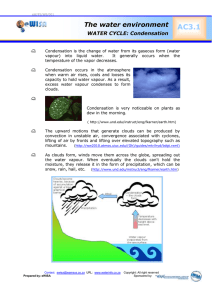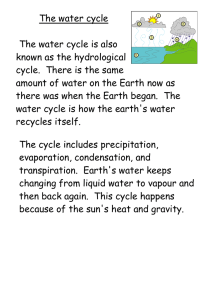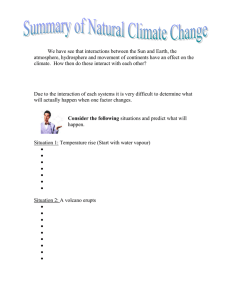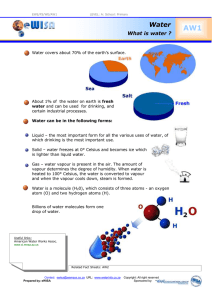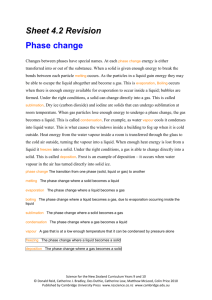Corrosion Technical Bulletin CTB 11
advertisement
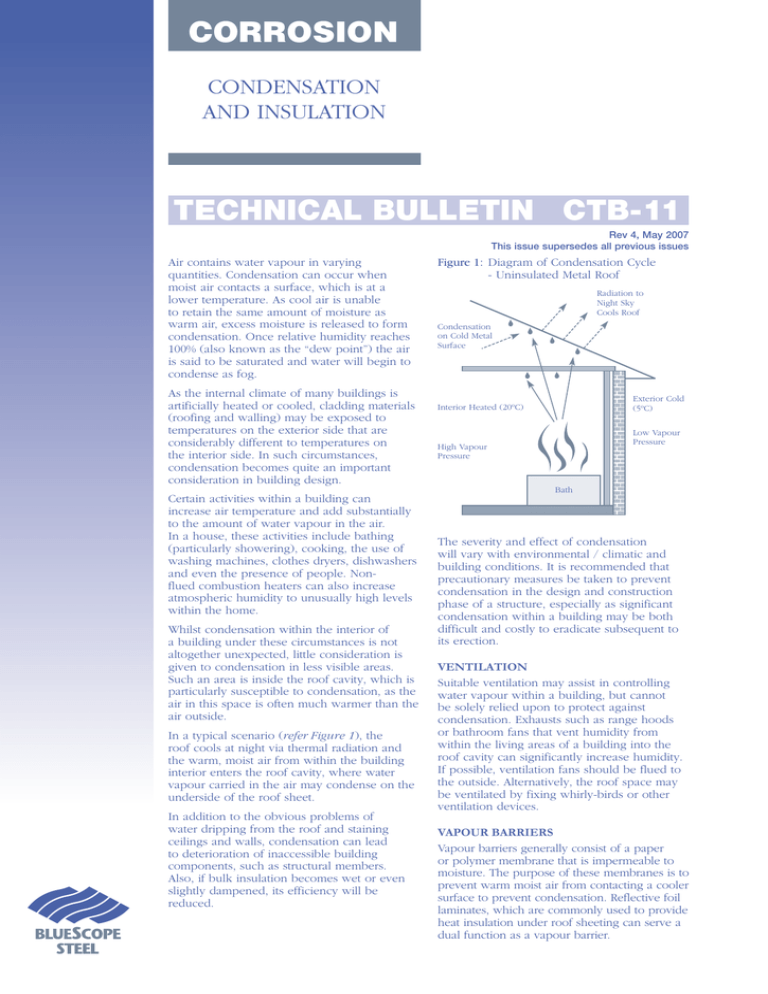
CORROSION CONDENSATION AND INSULATION TECHNICAL BULLETIN CTB-11 Rev 4, May 2007 This issue supersedes all previous issues Air contains water vapour in varying quantities. Condensation can occur when moist air contacts a surface, which is at a lower temperature. As cool air is unable to retain the same amount of moisture as warm air, excess moisture is released to form condensation. Once relative humidity reaches 100% (also known as the “dew point”) the air is said to be saturated and water will begin to condense as fog. As the internal climate of many buildings is artificially heated or cooled, cladding materials (roofing and walling) may be exposed to temperatures on the exterior side that are considerably different to temperatures on the interior side. In such circumstances, condensation becomes quite an important consideration in building design. Certain activities within a building can increase air temperature and add substantially to the amount of water vapour in the air. In a house, these activities include bathing (particularly showering), cooking, the use of washing machines, clothes dryers, dishwashers and even the presence of people. Nonflued combustion heaters can also increase atmospheric humidity to unusually high levels within the home. Whilst condensation within the interior of a building under these circumstances is not altogether unexpected, little consideration is given to condensation in less visible areas. Such an area is inside the roof cavity, which is particularly susceptible to condensation, as the air in this space is often much warmer than the air outside. In a typical scenario (refer Figure 1), the roof cools at night via thermal radiation and the warm, moist air from within the building interior enters the roof cavity, where water vapour carried in the air may condense on the underside of the roof sheet. In addition to the obvious problems of water dripping from the roof and staining ceilings and walls, condensation can lead to deterioration of inaccessible building components, such as structural members. Also, if bulk insulation becomes wet or even slightly dampened, its efficiency will be reduced. Figure 1: Diagram of Condensation Cycle - Uninsulated Metal Roof Radiation to Night Sky Cools Roof Condensation on Cold Metal Surface Exterior Cold (5ºC) Interior Heated (20ºC) Low Vapour Pressure High Vapour Pressure Bath The severity and effect of condensation will vary with environmental / climatic and building conditions. It is recommended that precautionary measures be taken to prevent condensation in the design and construction phase of a structure, especially as significant condensation within a building may be both difficult and costly to eradicate subsequent to its erection. VENTILATION Suitable ventilation may assist in controlling water vapour within a building, but cannot be solely relied upon to protect against condensation. Exhausts such as range hoods or bathroom fans that vent humidity from within the living areas of a building into the roof cavity can significantly increase humidity. If possible, ventilation fans should be flued to the outside. Alternatively, the roof space may be ventilated by fixing whirly-birds or other ventilation devices. VAPOUR BARRIERS Vapour barriers generally consist of a paper or polymer membrane that is impermeable to moisture. The purpose of these membranes is to prevent warm moist air from contacting a cooler surface to prevent condensation. Reflective foil laminates, which are commonly used to provide heat insulation under roof sheeting can serve a dual function as a vapour barrier. On a cool, clear night roof sheeting will radiate heat into the atmosphere until the temperature of the sheeting drops below that of the surrounding air, sometimes by as much as 5ºC. The sheeting will continue to radiate heat and remain colder than the air in contact with it until it is subjected to radiation from the sun. Until this time the water vapour in the air may condense on the roof sheeting, especially on the underside where it is in contact with warm air rising from the heated interior below. The method of installation for vapour barriers and/or bulk insulation materials will vary depending on the climate in which the building is located. A general rule of thumb is to install vapour barriers on the warm side of insulation materials. The manufacturer’s installation guidelines should be followed. Further information regarding vapour barriers and insulation requirements are available in AS 4200.2 and Volume 2, Part 3.12.1 of the Building Code of Australia, respectively. To minimise the risk of corrosion related to condensation under roof sheeting in cooler climates, a vapour barrier should be provided adjacent to the underside of the sheeting to prevent contact between the moist air and the roof sheet. The inclusion of a bulk insulation layer (wool blanket or similar) between the vapour barrier and the roof sheeting will insulate the laminate from the cold roof sheeting further reducing the risk of condensation. In most climates the vapour barrier should normally be installed on the warm internal side of the cladding. However, in tropical environments, including Darwin, Cairns, South East Asian countries or similar environments, the climate may be different. The air outside is typically warm and moist compared to cooler, air-conditioned interior regions of the building. By thoroughly sealing the overlaps of vapour barriers with waterproof adhesive tape, the efficiency of the system may be greatly increased. The laps should be about 100mm and kept in close contact when positioning the vapour barrier so the tape can be readily applied. The vapour barrier must be allowed to drape between the roof supports so the cold temperature of the roof sheeting will not be transmitted to the vapour barrier by contact. If this were to happen condensation could form on the underside of the vapour barrier and may drip into the ceiling space. To avoid condensation problems under these ‘tropical’ conditions the vapour barrier may be placed nearest the external building cladding. In the case of insulation blanket and foil, the blanket would face to the interior side (that is, opposite to the ‘temperate’ case). It is recommended that the insulation provider also be consulted prior to installing any insulation materials to ensure that the specific requirements of your building are met. Particularly in high-risk areas (where there are large differences in temperature and humidity between internal and external surfaces), it is important to seal joints and penetrations of the vapour barrier to minimise entry of air from the warm side via sheet overlaps and fastener penetrations. Figure 2: Insulation configuration for temperate (a) and tropical (b) scenarios Roof Sheets Roof Sheets Vapour Barrier Vapour Barrier Insulation Blanket (a) Temperate Insulation Blanket (b) Tropical Figure 3: Photo depicting moisture penetration due to the absence of a vapour barrier in a tropical environment. INSTALLATION Care should be taken when installing insulation blanket, to avoid significantly overhanging the last batten adjacent to any rainwater channelling components, such as gutters and valleys. If the wool blanket protrudes into the gutter, it is likely to become wet and could function as a “wick”, drawing water throughout a significant area of the insulation blanket (Figure 4a). If the insulation blanket becomes wet, not only are the thermal properties of the material compromised, but moisture may be held in direct contact with the underside of steel roof sheets for significant lengths of time. In such a situation, accelerated corrosion of the roof sheets may occur, initiating from the underside of the sheet. Under these circumstances, corrosion of the roof sheets is generally not detectable until perforation of the material has occurred. To avoid this, insulation material should be trimmed back well clear of the drip edge of the roof sheet to avoid overhang into the gutter. Figure 4: Poor Installation (a) and Recommended Installation (b) scenarios. (a) Poor Installation (b) Recommended Installation NOISE In addition to the benefits offered by vapour barriers for condensation reduction, these materials also offer further benefit in terms of reducing the noise that can be generated by metal roofs during daily heating and cooling cycles. As the sun warms metal roof sheets during the day the sheets expand, which creates movement of the metal over the roof battens. Where the roof sheets are installed on timber battens, the high friction present between the two surfaces results in energy being built up. This energy can be released suddenly, resulting in an audible “popping” noise. A similar process occurs as the roof cools at night as the sheets contract. The presence of a vapour barrier can greatly assist in eliminating this phenomenon. The vapour barrier is installed between the battens and the roof sheet, reducing friction and preventing the build-up of energy. This results in a relatively smooth and quiet expansion and contraction cycle. SUMMARY • Condensation prevention should be considered in the design and construct phase of any building project • Ventilation can assist in condensation reduction, but might not prevent it from occurring in all cases • Refer to your insulation supplier for specific recommendations for your vapour barrier and insulation requirements • Refer to Building Code of Australia Volume 2, Part 3.12.1 and your insulation material supplier for further information regarding insulation requirements • Refer to Australian Standard AS 4200.2 Pliable Building Membranes And Underlays - Installation Requirements for additional information • Local or State Government authorities may impose further requirements regarding the use of insulation materials The information and advice contained in this Bulletin is of a general nature only, and has not been prepared with your specific needs in mind. You should always obtain specialist advice to ensure that the materials, approach and techniques referred to in this Bulletin meet your specific requirements. BlueScope Steel Limited makes no warranty as to the accuracy, completeness or reliability of any estimates, opinions or other information contained in this Bulletin, and to the maximum extent permitted by law, BlueScope Steel Limited disclaims all liability and responsibility for any loss or damage, direct or indirect, which may be suffered by any person acting in reliance on anything contained in or omitted from this document. BlueScope is a registered trade mark of BlueScope Steel Limited. Please ensure you have the current Technical Bulletin as displayed at www.bluescopesteel.com.au BlueScope Steel Copyright 2007 BlueScope Steel Limited SYDNEY MELBOURNE BRISBANE ADELAIDE PERTH Telephone: Telephone: Telephone: Telephone: Telephone: (02) 9795 6700 (03) 9586 2222 (07) 3845 9300 (08) 8243 7333 (08) 9365 6666 OVERSEAS AUSTRALIA BlueScope Steel Limited ABN 16 000 011 058 BlueScope Steel (AIS) Pty Ltd ABN 19 000 019 625 BlueScope Steel (Malaysia) Sdn Bhd BlueScope Steel (Thailand) Limited PT BlueScope Steel Indonesia BlueScope Steel Southern Africa (Pty) Limited Telephone: (603) 3250 8333 Telephone: (66 38) 685 710 Telephone: (62 21) 570 7564 Telephone: (27 21) 555 4265 Produced by Artimprint (02) 9984 8586
